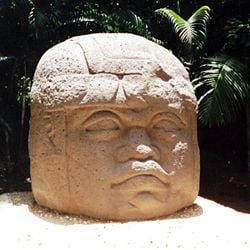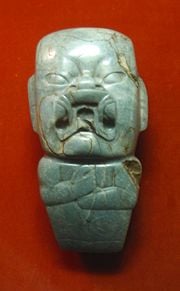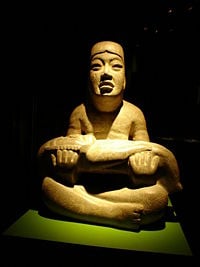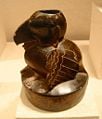Olmec
The Olmec were an ancient Pre-Colombian people living in the tropical lowlands of south-central Mexico, roughly in what are the modern-day states of Veracruz and Tabasco on the Isthmus of Tehuantepec. Their cultural influence, however, extends far beyond this region.
The Olmec flourished during the Formative (or Preclassic) period of Mesoamerican chronology, dating from 1200 B.C.E. to about 400 B.C.E., and are believed to have been the progenitor civilization of later Mesoamerican civilizations. However their culture disappeared for reasons unknown. Still, much of their culture remains and the Olmec are credited (at least speculatively) with many innovations in Mesoamerica, including writing, the calendar using zero, and the Mesoamerican ballgame prevalent in the region. Their place in human history remains significant and not to be forgotten, most obviously seen in the colossal stone heads, examples of which have been found around the area they inhabited.
Etymology of the name "Olmec"
The name "Olmec" means "rubber people" in Nahuatl, the language of the Aztec, and was the Aztec name for the people who lived in the area of the Olmec heartland in the fifteenth and sixteenth centuries, some 2000 years after what we know as the Olmec culture died out. The term, which roughly translates as "those who live in the rubber land," refers to the practice of extracting latex from Castilla elastica, a rubber tree in the area.[1]
Early modern explorers and archaeologists, however, mistakenly applied the name "Olmec" to the rediscovered ruins and artifacts in the heartland decades before it was understood that these were not created by people the Aztecs knew as the "Olmec," but rather a culture that was 2000 years older. Despite the mistaken identity, the name has remained.
It is not known what name the ancient Olmec used for themselves; some later Mesoamerican accounts seem to refer to the ancient Olmec as "Tamoanchan."[2]
History of scholarly research on the Olmec
Olmec culture was unknown to historians until the mid-nineteenth century. In 1862 the fortuitous discovery of a colossal head near Tres Zapotes, Veracruz by José Melgar y Serrano marked the first significant rediscovery of Olmec artifacts.[3] In the latter half of the nineteenth century, Olmec artifacts such as the Kunz Axe came to light and were recognized as belonging to a unique artistic tradition.

Frans Blom and Oliver La Farge made the first detailed descriptions of La Venta and San Martín Pajapan Monument 1 during their 1925 expedition. The 1.4 m (5.5 ft) high statue shows a crouching young lord caught in the act of raising a large ceremonial bar, his right hand is under one end and his left over the other end. This pose, nearly identical to that of the "twins" at El Azuzul, is thought to represent a ruler or shaman (or both) shown in the ritual act of raising the Mesoamerican world tree or axis mundi, an act that establishes the center of the world and connects the earthly plane with the worlds above and below.[4] However, at the time, most archaeologists assumed the Olmec were contemporaneous with the Maya – even Blom and La Farge were, in their own words, "inclined to ascribe them to the Maya culture."[5]
Matthew Stirling of the Smithsonian Institution conducted the first detailed scientific excavations of Olmec sites in the 1930s and 1940s. Stirling, along with art historian Miguel Covarrubias, became convinced that the Olmec predated most other known Mesoamerican civilizations. Debate as to whether the Olmec were the originating culture in Latin and South America soon began. It was not long before radiocarbon dating proved the antiquity of the Olmec civilization, although the "mother culture" question has continued to generate much debate over many decades.[6] Part of the problem is the lack of materials and understanding of the Olmec civilization. Compared to the Aztecs and Mayans, little remains of the Olmec.
In part because little is known of them, a number of Olmec alternative origin speculations have been put forth. The striking similarities between Ancient Egypt and the ancient Mesoamerican civilizations have led to speculation of connections if not common origins. An exhibition in Mexico which included both Egyptian and Olmec artifacts revealed cultural parallels in religion, architecture, and the arts, supporting such speculation.[7] Although several of these speculations, particularly the theory that the Olmecs were of African origin popularized by Ivan van Sertima's book They Came Before Columbus, have become well-known within popular culture, they have not been considered credible by the majority of Mesoamerican researchers.
The consensus view of the Olmec, and their neighboring cultures with whom they had contact, has been that they developed their own characters founded entirely on a remarkably interlinked and ancient cultural and agricultural heritage that was locally shared, but arose quite independently of any extra-hemispheric influences.[8] The Olmec and their achievements arose from influences and traditions that were wholly indigenous to the region:
There simply is no material evidence of any Pre-Hispanic contact between the Old World and Mesoamerica before the arrival of the Spanish in the sixteenth century.[9]
Olmec Time-Line
Olmec history originated at its base within San Lorenzo Tenochtitlán, where distinctively Olmec features begin to emerge before 1200 B.C.E.[8] The Olmec heartland is characterized by swampy lowlands punctuated by low hills, ridges, and volcanoes. The Tuxtlas Mountains rise sharply in the north, along the Gulf of Mexico's Bay of Campeche. The rise of civilization here was probably assisted by the local ecology of well-watered rich alluvial soil, encouraging high maize production. This ecology may be compared to that of other ancient centers of civilization: the Nile, Indus, and Yellow River valleys, and Mesopotamia.
San Lorenzo was all but abandoned around 900 B.C.E. at about the same time that La Venta rose to prominence. Environmental changes may have been responsible for this move, with certain important rivers changing course. A wholesale destruction of many San Lorenzo monuments also occurred around this time, circa 950 B.C.E., which may point to an internal uprising or, less likely, an invasion.[5] Following the decline of San Lorenzo, La Venta became the most prominent Olmec center, lasting from 900 B.C.E. until its abandonment around 400 B.C.E. During this period, the Great Pyramid and various other ceremonial complexes were built at La Venta.[8]
It is not known with any clarity what caused the eventual extinction of the Olmec culture. It is known that between 400 and 350 B.C.E. population in the eastern half of the Olmec heartland dropped precipitously, and the area remained sparsely inhabited until the nineteenth century.[8] This depopulation could have been the result of environmental changes—such as important rivers changing course or silting up due to agricultural practices.[8]
Whatever the cause, within a few hundred years of the abandonment of the last Olmec cities, successor cultures had become firmly established. The Tres Zapotes site, on the western edge of the Olmec heartland, continued to be occupied well past 400 B.C.E., but without the hallmarks of the Olmec culture. This post-Olmec culture, often labeled Epi-Olmec, has features similar to those found at Izapa, some distance to the southeast.
Culture
The Olmec are credited, or speculatively credited, with many "firsts" in Mesoamerican civilization, including the Mesoamerican ballgame, bloodletting and perhaps human sacrifice, writing and epigraphy, and the invention of zero and the Mesoamerican calendar. Their political arrangements of strongly hierarchical city-state kingdoms were repeated by nearly every other Mexican and Central American civilization that followed. Some researchers, including artist and art historian Miguel Covarrubias, have even postulated that the Olmec formulated the forerunners of many of the later Mesoamerican deities.[10] Whether they directly influenced other civilizations, or were merely the first to develop common features of advanced civilizations, (what is known as the "Mother" vs. "Sister" culture debate[6]) is a question still left unanswered, yet the debate should not take away from appreciation of the Olmec achievements, some of which are described below.
Mesoamerican ballgame
The Olmec were likely the originators of the Mesoamerican ballgame so prevalent among later cultures of the region and used for recreational and religious purposes.[4] A dozen rubber balls dating to 1600 B.C.E. or earlier have been found in El Manatí, an Olmec sacrificial bog 10 kilometerss east of San Lorenzo Tenochtitlan.[11] These balls predate the earliest ballcourt yet discovered at Paso de la Amada, circa 1400 B.C.E. The fact that the balls were found with other sacrificial items, including pottery and jadeite celts, indicates that even at this early date, the ballgame had religious and ritual connotations. The rules of the ballgame are not known, but judging from its descendant, ulama, which is still practiced by indigenous natives in South America, it was probably similar to racquetball or volleyball, where the aim is to keep the ball in play.
Bloodletting and sacrifice
There is strong evidence that the Olmec practiced bloodletting, or autosacrifice, the ritualized practice of drawing blood from oneself. Numerous natural and ceramic stingray spikes and maguey thorns have been found in the archaeological record of the Olmec heartland.[12]
The argument that the Olmec instituted human sacrifice is significantly more speculative. No Olmec or Olmec-influenced sacrificial artifacts have yet been discovered and there is no Olmec or Olmec-influenced artwork that unambiguously shows sacrificial victims (like, for example, the danzante figures of Monte Albán) or scenes of human sacrifice (such as can be seen in the famous ball-court mural from El Tajin).[4]
However, at the El Manatí site, dis-articulated skulls and femurs as well as complete skeletons of newborn or unborn children have been discovered amidst the other offerings, leading to speculation concerning infant sacrifice. Evidence was not found, though, concerning how the infants met their deaths.[11]
Writing and language
Because of a lack of evidence, academics have debated whether or not the Olmec may have been the first civilization in the Western Hemisphere to develop a writing system. Symbols found in 2002 and 2006 date to 650 B.C.E.[13] and 900 B.C.E.[14] respectively, preceding the oldest Zapotec writing dated to about 500 B.C.E. The 2002 find at the San Andrés site shows a bird, speech scrolls, and glyphs that are similar to the later Mayan hieroglyphs.[15]
Known as the Cascajal block, the 2006 find from a site near San Lorenzo, showed a set of 62 symbols, 28 of which are unique, carved on a serpentine block. This find has been hailed as the "earliest pre-Colombian writing."[16] Some archaeologists have remained skeptical, however, because of the stone's singularity, the fact that it had been removed from any archaeological context, and because it bears no apparent resemblance to any other Mesoamerican writing system.[17]
There are also well-documented later hieroglyphs known as "Epi-Olmec," and while there are some who believe that Epi-Olmec may represent a transitional script between an earlier Olmec writing system and Maya writing, this is only speculation.
Even less is known about the spoken language of the Olmec. Since the Mixe-Zoquean languages still are, and historically are known to have been, spoken in an area corresponding roughly to the Olmec heartland, it has generally been regarded as probable that the Olmec spoke a Mixe-Zoquean language.[18] There are a core number of loanwords which have apparently spread from a Mixe-Zoquean language into many other Mesoamerican languages. These core loanwords can be seen as an indicator that the Olmec spoke a language which is an ancestor of the Mixe-Zoquean languages, and that they spread a vocabulary particular to their culture to the other peoples of Mesoamerica.[18]
Compass
The find of an Olmec hematite artifact, fitted with a sighting mark and fully operational as a compass, has led to the proposal that "the Olmec may have discovered and used the geomagnetic lodestone compass earlier than 1000 B.C.E."[19]
Mesoamerican Long Count calendar and zero concept
The Long Count calendar used by many subsequent Mesoamerican civilizations, as well as the concept of zero, may have been devised by the Olmec. Because the six artifacts with the earliest Long Count calendar dates were all discovered outside the immediate Maya homeland, it is likely that this calendar predated the Maya and was possibly the invention of the Olmec.[8] Indeed, three of these six artifacts were found within the Olmec heartland area. However, the fact that the Olmec civilization had come to an end by the fourth century B.C.E., several centuries before the earliest known Long Count date artifact, argue against an Olmec origin.
The Long Count calendar required the use of zero as a place-holder within its vigesimal (base-20) positional numeral system. A shell glyph—![]() —was used as a zero symbol for these Long Count dates, the second oldest of which, on Stela C at Tres Zapotes, has a date of 32 B.C.E. This is one of the earliest uses of the zero concept in history.[8]
—was used as a zero symbol for these Long Count dates, the second oldest of which, on Stela C at Tres Zapotes, has a date of 32 B.C.E. This is one of the earliest uses of the zero concept in history.[8]
Art
Olmec artforms remain in works of both monumental statuary and small jade work. Much Olmec art is highly stylized and uses an iconography reflective of a religious meaning. Some Olmec art, however, is surprisingly naturalistic, displaying an accuracy of depiction of human anatomy perhaps equaled in the pre-Columbian New World only by the best Maya Classic era art. Common motifs include downturned mouths and slit-like slanting eyes, both of which are seen as representations of "were-jaguars." Olmec figurines are also found abundantly in sites throughout the Formative Period.
Olmec colossal heads
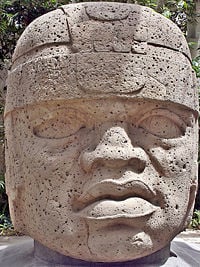
Perhaps the best-recognized Olmec artforms are their enormous helmeted heads. As no known pre-Columbian text explains these, these impressive monuments have been the subject of much speculation. Given the individuality of each, including a large symbol on each "helmet," these heads seem to be portraits of significant people, warriors or perhaps kings.[2]
The heads range in size from the Rancho La Cobata head, at 3.4 meters (11 ft) high, to the pair at Tres Zapotes, at 1.47 meters (4.8 ft). Some sources estimate that the largest weighs as much as 40 tons, although most reports place the larger heads at 20 tons. The heads were carved from single blocks or boulders of volcanic basalt, quarried in the Tuxtlas Mountains. The Tres Zapotes heads were sculpted from basalt found on San Martin Volcano. The lowland heads were possibly carved from the Cerro Cintepec. It has been estimated that moving a colossal head required the efforts of 1,500 people for three to four months.[4] It is possible that the heads were carried on large balsa rafts from the Llano del Jicaro quarry to their final locations. To reach La Venta, roughly 80 km (50 miles) away, the rafts would have had to move out onto choppy waters of the Bay of Campeche.
Some of the heads, and many other monuments, have been variously mutilated, buried and disinterred, reset in new locations and/or reburied. It is known that some monuments were recycled or recarved, but it is not known whether this was simply due to the scarcity of stone or whether these actions had ritual or other connotations. It is suspected that some mutilation had significance beyond mere destruction, but internal conflicts or, less likely, invasion have not been ruled out.[8]
Religion and mythology
Olmec mythology has left no documents comparable to the Popul Vuh from Maya mythology, and therefore any exposition of Olmec mythology must rely on interpretations of surviving monumental and portable art, and comparisons with other Mesoamerican mythologies. Olmec art shows that such deities as the Feathered Serpent, a Man of Crops, and the Rain Spirit were already in the Mesoamerican pantheon in Olmec times. There is also considerable evidence for shamans in the Olmec archaeological record, particularly in the so-called "transformation figurines."[8]
- Feathered serpent
The mythological figure of the feathered or plumed serpent depicted throughout North America and Mesoamerica probably originated in Olmec times. In later traditions the Quetzal Feathered Serpent deity was known as the inventor of books and the calendar, the giver of maize corn to humankind, and sometime as a symbol of death and resurrection, often associated with the planet Venus. Art and iconography clearly demonstrate the importance of the Feathered Serpent Deity in Classic era as well as Olmec art.
- Man of Crops
The Man of Crops is a fertility figure in Mesoamerican mythology. The Man of Crops was a human man or boy who chose to give his life so that his people might grow food. The heroic Man of Crops is sometimes mentored or assisted by a god figure from the other world. Among the Olmec, gods are often depicted with a distinct cleft on the forehead, perhaps identifying this characteristic as divine. A carved celt from Veracruz shows a representation of God II, or the Maize God, growing corn from his cleft, and also shows this god with the snarling face associated with the jaguar.[20]
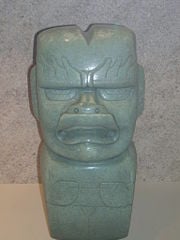
- Rain Spirit
The Olmec image of the rain spirit appears frequently in the mythology of succeeding cultures. Invariably the rain spirit is male, though he may have a wife who shares authority over the waters. Often he is perceived as a child or a young man, sometimes as a dwarf. He may also be portrayed as a powerful rain god, with many helpers.
- Jaguar
The Olmec carved items from fine jade and jadeite, including many human figures with strong jaguar features. As the jaguar was an indigenous predator in the area, jaguar figures may visually represent an Olmec myth about the interaction of the jaguar or a jaguar spirit with human beings. The large number of what are thought to be jaguar or were-jaguar images, led to the speculation that the Olmec considered the jaguar or were-jaguar as a god or deity (as the Egyptians did with Anubis, for example), or as shamans with the ability to transform into powerful jaguars.
Social and political life
Little is directly known about the societal or political structure of Olmec society. Although it is assumed by most researchers that the colossal heads and several other sculptures represent rulers, there is nothing like the Maya stelae which name specific rulers and provide the dates of their rule.
Instead, archaeologists have relied on the available data, such as large- and small-scale site surveys. The Olmec heartland, for example, shows considerable centralization, first at San Lorenzo and then at La Venta. No other Olmec heartland site comes close to these in terms of size or in quantity and quality of architecture and sculpture. This demographic centralization led archaeologists to propose that Olmec society was also highly centralized, with a strongly hierarchical structure and an elite that was able to use their control over materials, such as monumental stone and water, to exert control over the people and legitimize their regime.[21]
Despite their size, San Lorenzo and La Venta were largely ceremonial centers, and the vast majority of the Olmec lived in villages similar to present-day villages and hamlets in Tabasco and Veracruz. These villages were located on higher ground and consisted of several scattered houses. A modest temple may have been associated with the larger villages. The individual dwellings would consist of a house, an associated lean-to, and one or more storage pits (similar in function to a root cellar). A nearby garden was used for medicinal and cooking herbs and for smaller crops such as the domesticated sunflower. Fruit trees, such as avocado or cacao, were likely available nearby.[22]
Although the river banks were used to plant crops between flooding periods, the Olmec also likely practiced swidden (or slash-and-burn) agriculture to clear the forests and shrubs, and to provide new fields once the old fields were exhausted.[15] Fields were located outside the village, and were used for maize, beans, squash, manioc, sweet potato, as well as cotton. Based on studies of two villages in the Tuxtlas Mountains, maize cultivation became increasingly important to the Olmec diet over time, although the diet remained fairly diverse.[23]
Fruits and vegetables were supplemented with fish, turtle, snake, and mollusks from the nearby rivers, and crabs and shellfish in the coastal areas. Birds were available as food sources, as were game including peccary, opossum, raccoon, rabbit, and in particular deer.[23] Despite the wide range of hunting and fishing available, midden surveys in San Lorenzo have found that the domesticated dog was the single most plentiful source of animal protein.[24]
Gallery
An Olmec jade mask.
Notes
- ↑ James D. Farmer, Olmec Civilization Rises Salem Press, 2004. Retrieved October 16, 2008.
- ↑ 2.0 2.1 Michael D. Coe and Rex Koontz, Mexico: From the Olmec to the Aztecs. (Thames and Hudson, 2002, ISBN 050028346X).
- ↑ Matthew Stirling, "Early History of the Olmec Problem," in Dumbarton Oaks Conference on the Olmec, E. Benson (ed.). (Washington, DC: Dumbarton Oaks, 1967, ISBN 0884020983). Retrieved October 15, 2008.
- ↑ 4.0 4.1 4.2 4.3 Christopher Pool, Olmec Archaeology and Early Mesoamerica. (Cambridge University Press, 1997, ISBN 052178882X).
- ↑ 5.0 5.1 Michael D. Coe, "San Lorenzo and the Olmec Civilization," in Dumbarton Oaks Conference on the Olmec, Washington, DC: Dumbarton Oaks, 1967. Retrieved October 15, 2008.
- ↑ 6.0 6.1 John Noble Wilford, Mother Culture, or Only a Sister? The New York Times, March 15, 2005. Retrieved October 14, 2008.
- ↑ Robin Emmott, Snake-bird gods fascinated both Aztecs and pharaohs Reuters, September 24, 2007. Retrieved October 16, 2008.
- ↑ 8.0 8.1 8.2 8.3 8.4 8.5 8.6 8.7 8.8 Richard A. Diehl, The Olmecs: America's First Civilization (Thames & Hudson, 2005, ISBN 0500285039).
- ↑ Karl Taube, "The Origin and Development of Olmec Research" in Olmec Art at Dumbarton Oaks. Retrieved October 15, 2008. (Washington, DC: Dumbarton Oaks Research Library and Collection, 2004, ISBN 0884022757).
- ↑ Miguel Covarrubias, "Olmec Art or the Art of La Venta," trans. Robert Pirazzini (1946), reprinted in Pre-Colombian Art History: Selected Readings, A. Cordy-Collins and Jean Stern (eds.) (Peek Publications, 1977, ISBN 0917962419).
- ↑ 11.0 11.1 Ponciano C. Ortíz, María del Carmen Rodríguez, Olmec Ritual Behavior at El Manatí: A Sacred Space in Social Patterns in Pre-Classic Mesoamerica, David C. Grove and Rosemary A. Joyce (eds.), (Washington DC: Dumbarton Oaks Research Library and Collection, 1999), 225-254. Retrieved October 15, 2008.
- ↑ Rosemary A. Joyce, Richard Edging, Karl Lorenz, and Susan Gillespie, Olmec Bloodletting: An Iconographic Study in Sixth Palenque Roundtable, 1986, V. Fields (ed.) (Norman, OK: University of Oklahoma Press, 1991). Retrieved October 15, 2008.
- ↑ Bruce Bower, Script Delivery: New World writing takes disputed turn Science News 162(23) (2002): 355. Retrieved October 11, 2008.
- ↑ John Noble Wilford, "Writing May Be Oldest in Western Hemisphere"The New York Times, September 15, 2006. Retrieved October 11, 2008.
- ↑ 15.0 15.1 Mary Pohl, Kevin O. Pope, and Christopher von Nagy Olmec Origins of Mesoamerican Writing Science 298(5600) (December 6, 2002): 1984-1987. Retrieved October 15, 2008.
- ↑ J. R. Minkel, Stone Etchings Represent Earliest New World Writing Scientific American, Archaeology & Paleontology, September 14, 2006. Retrieved October 15, 2008.
- ↑ Mason Inman, Oldest Writing in New World Discovered, Scientists Say National Geographic News, September 14, 2006. Retrieved October 11, 2008.
- ↑ 18.0 18.1 Lyle Campbell and Terrence Kaufman, "A Linguistic Look at the Olmec," American Antiquity 41(1) (January, 1976):80-89.
- ↑ John B. Carlson, “Lodestone Compass: Chinese or Olmec Primacy? Multidisciplinary Analysis of an Olmec Hematite Artifact from San Lorenzo, Veracruz, Mexico,” Science, New Series, 189(4205) (September 5, 1975): 753-760.
- ↑ Michael D. Coe, "Olmec Jaguars and Olmec Kings" In E. P. Benson (ed.), The Cult of the Feline (Washington, DC: Dumbarton Oaks, 1972, ISBN 0884020436).
- ↑ Ann Cyphers, From Stone to Symbols: Olmec Art in Social Context at San Lorenzo Tenochtitlán in Social Patterns in Pre-Classic Mesoamerica, David C. Grove and Rosemary A. Joyce (eds.), (Washington DC: Dumbarton Oaks, 1999). Retrieved October 15, 2008.
- ↑ Kevin O. Pope, Mary E. D. Pohl, John G. Jones, David L. Lentz, Christopher von Nagy, Francisco J. Vega, and Irvy R. Quitmyer, Origin and Environmental Setting of Ancient Agriculture in the Lowlands of Mesoamerica Science 292(5520) (May 18, 2001): 1370-1373. Retrieved October 15, 2008.
- ↑ 23.0 23.1 Amber Van Derwarker, Farming, Hunting, and Fishing in the Olmec World (University of Texas Press, 2006, ISBN 0292709803).
- ↑ Nigel Davies, The Ancient Kingdoms of Mexico (Penguin, 1991, ISBN 0140135871).
ReferencesISBN links support NWE through referral fees
- Bierhorst, John. The Mythology of Mexico and Central America. William Morrow, 1990. ISBN 0688112803
- Campbell, Lyle, and Terrence Kaufman, "A Linguistic Look at the Olmec," American Antiquity 41(1) (January, 1976): 80-89.
- Coe, Michael D. "Olmec Jaguars and Olmec Kings" edited by E. P. Benson, The Cult of the Feline. Washington, DC: Dumbarton Oaks, 1972. ISBN 0884020436
- Coe, Michael D., and Rex Koontz. Mexico: From the Olmecs to the Aztecs. London: Thames and Hudson, 2008. ISBN 978-0500287552
- Davies, Nigel. The Ancient Kingdoms of Mexico. Penguin, 1991. ISBN 0140135871
- Diehl, Richard A. The Olmecs: America's First Civilization. Thames & Hudson, 2005. ISBN 0500285039
- Emmott, Robin. Snake-bird gods fascinated both Aztecs and pharaohs Reuters, September 24, 2007. Retrieved October 16, 2008.
- Grove, D. C. "Olmec monuments: Mutilation as a clue to meaning," in The Olmec and their Neighbors: Essays in Memory of Matthew W. Stirling, edited by E. P. Benson, 49–68. Washington, DC: Dumbarton Oaks Research Library, 1981. ISBN 0884020983
- Luckert, Karl W. Olmec Religion: A Key to Middle America and Beyond. Norman, OK: University of Oklahoma Press, 1976. ISBN 0806112980
- Martínez, Ma. del Carmen Rodríguez, Ponciano Ortíz Ceballos, Michael D. Coe, Richard A. Diehl, Stephen D. Houston, Karl A. Taube, and Alfredo Delgado Calderón. Oldest Writing in the New World, Science 313(5793) (September 15, 2006):1610-1614. Retrieved October 15, 2008.
- Minkel, J. R. Stone Etchings Represent Earliest New World Writing Scientific American, Archaeology & Paleontology, September 14, 2006. Retrieved October 15, 2008.
- National Science Foundation; Scientists Find Earliest "New World" Writings in Mexico, December 5, 2002. Retrieved October 16, 2008.
- Pool, Christopher. Olmec Archaeology and Early Mesoamerica. Cambridge University Press, 1997. ISBN 052178882X
- Rose, Mark. "Olmec People, Olmec Art", in Archaeology (online), the Archaeological Institute of America, March 28, 2005. Retrieved October 16, 2008.
- Skidmore, Joel. "The Cascajal Block: The Earliest Precolumbian Writing," Mesoweb, 2006. Retrieved October 16, 2008.
- Stoltman, James B., Joyce Marcus, Kent V. Flannery, James H. Burton, and Robert G. Moyle. Petrographic evidence shows that pottery exchange between the Olmec and their neighbors was two-way. Proceedings of the National Academy of Sciences of the United States of America, June 17, 2005. Retrieved October 16, 2008.
- Taube, Karl. "The Origin and Development of Olmec Research" in Olmec Art at Dumbarton Oaks. Retrieved October 15, 2008. Washington, DC: Dumbarton Oaks Research Library and Collection, 2004. ISBN 0884022757
- Van Derwarker, Amber. Farming, Hunting, and Fishing in the Olmec World. University of Texas Press, 2006. ISBN 0292709803
- Van Sertima, Ivan. They Came Before Columbus: The African Presence in Ancient America. New York, NY: Random House, 2003. ISBN 0812968174
- Wilford, John Noble, Mother Culture, or Only a Sister?, The New York Times, March 15, 2005. Retrieved October 25, 2008.
External links
All links retrieved November 17, 2022.
Credits
New World Encyclopedia writers and editors rewrote and completed the Wikipedia article in accordance with New World Encyclopedia standards. This article abides by terms of the Creative Commons CC-by-sa 3.0 License (CC-by-sa), which may be used and disseminated with proper attribution. Credit is due under the terms of this license that can reference both the New World Encyclopedia contributors and the selfless volunteer contributors of the Wikimedia Foundation. To cite this article click here for a list of acceptable citing formats.The history of earlier contributions by wikipedians is accessible to researchers here:
The history of this article since it was imported to New World Encyclopedia:
Note: Some restrictions may apply to use of individual images which are separately licensed.
